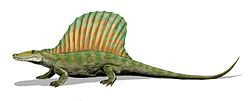| Reiszia Temporal range: middle Permian | |
|---|---|
| Scientific classification | |
| Domain: | Eukaryota |
| Kingdom: | Animalia |
| Phylum: | Chordata |
| Clade: | Synapsida |
| Clade: | Therapsida |
| Suborder: | † Biarmosuchia |
| Family: | † Nikkasauridae |
| Genus: | † Reiszia |
| Species | |
| |
Reiszia is an extinct genus of therapsids from European Russia belonging to the family Nikkasauridae.





